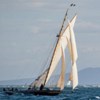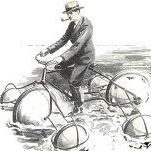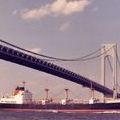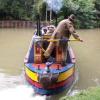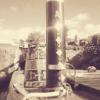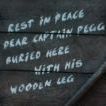Leaderboard
Popular Content
Showing content with the highest reputation on 05/06/23 in all areas
-
This post cannot be displayed because it is in a forum which requires at least 10 posts to view.
-
4 points
-
This post cannot be displayed because it is in a forum which requires at least 10 posts to view.
-
This post cannot be displayed because it is in a forum which requires at least 10 posts to view.
-
This post cannot be displayed because it is in a forum which requires at least 10 posts to view.
-
On a full length boat you sometimes need to put the rudder right over to be able to reverse up to the cill far enough to open the bottom gate(s). If the rudder travel is limited the rudder must be more vulnerable to damage when a surge carries the boat rapidly backwards in a lock.3 points
-
This post cannot be displayed because it is in a forum which requires at least 10 posts to view.
-
3 points
-
Slide the stem up the plate on the gate. The water movement holds the boat in place, just make sure you are touching before opening paddles and most importantly there's nothing sticking out of the plate!3 points
-
It doesn't appeal to me for a couple of reasons in my view. 1 - once in position you have no way of checking whether ant rusting is taking place and if for any reason the area where the concrete is gets wet you won't be able to check that it hasn't found its way underneath. Boats can and do flex, and although it may appear to be a perfect sea, over time ot may move slightly allowing water ingress. 2 - If ever you need to remove some or all of the ballast to change the trim of the boat or if you add weighty items which may lead to a need to redistribute ballast it will be a major job to remove. In my view it is a quick way of adding ballast but for the reasons above it may be a problem in later years after purchase. Howard3 points
-
That is true if the boat is moving forward but a stationary boat with a big rudder can turn in its own length by putting the rudder at 90deg using fwd an reverse. The rudder blocks the flow of the water to from the prop as well as pushing water out sideways. If you see what I mean2 points
-
I don't. There are times when being able to put the tiller hard over is advantageous. A rudder stop is the equivalent of stabilisers on a bike, might be handy if you have no idea but prevents you using the full capabilities of the vessel.2 points
-
Well the best news for this trip is not one single volockie encountered. No-one at Fradley, or Bratch, or any of the other locks including Stourbridge 16 and Delph. By some miracle we seemed to cope! And it was very relaxing!2 points
-
This post cannot be displayed because it is in a forum which requires at least 10 posts to view.
-
The water doesn't evaporate, it becomes chemically combined within the concrete. Concrete doesn't dry, it goes off.2 points
-
This post cannot be displayed because it is in a forum which requires at least 10 posts to view.
-
This post cannot be displayed because it is in a forum which requires at least 10 posts to view.
-
This post cannot be displayed because it is in a forum which requires at least 10 posts to view.
-
This post cannot be displayed because it is in a forum which requires at least 10 posts to view.
-
Confirmed that this solved the issue! Thanks everyone, definitely learnt something from this.2 points
-
Could a mitigation for tiller injuries be as simple is reducing the arc through which the tiller can swing? In almost all NB designs the rudder can swing until the lifting eye on the top rear of the rudder hits the side of the counter, and that's close to 90 degrees. It's actually a far wider swing than is useful for steering: the maximum sideways force is generated when the the rudder is about 45 degrees (or maybe a bit more) from straight ahead. Moving the rudder further than that is pointless or even self defeating. If stops could added to the rudder mechanism, maybe in the top bearing, to control the rudder movement over a controlled arc rather that the arc that just happens to be allowed by the geometry of the rudder/lifting-eye/counter then it could be engineered to be less likely to toss a steerer over the side whilst still allowing enough movement for efficient steering. MP.2 points
-
This post cannot be displayed because it is in a forum which requires at least 10 posts to view.
-
I've mentioned this before, but worth repeating. I was following a boat whose steerer was swept off the counter. She was fiddling with an umbrella, the rudder hit an underwater obstruction, it swung round and in she went. I always steered from the step with the tiller in the small of my back.2 points
-
With hindsight it should have been left there so nothing other than narrow beam craft could pass through!2 points
-
This post cannot be displayed because it is in a forum which requires at least 10 posts to view.
-
Best boats have extra thick base plates 13-15mm or so, then no need for ballast apart from balancing ballast😉 No concrete for me.1 point
-
Well some of the BCN locks have multiple ground paddle outlets including behind the bottom gates. But otherwise (and I’m totally guessing!) it might be to do with the direction the water comes out of the paddle culvert. If the water comes out pointing across the lock, the flow will be turbulent, just thrash around as it bounces off the opposite wall etc, and so Bernoulli doesn’t really kick in. But if the flow is directed more along the bottom of the lock, then the flow will be more laminar and that is when you get the Bernoulli effect.1 point
-
This post cannot be displayed because it is in a forum which requires at least 10 posts to view.
-
As the current owner of Belfast I was fascinated to see the boat when I got the DVD a few years ago. This screengrab shows Belfast as she appeared in the 60s - a very basic version of the BW blue and yellow livery without the yellow lining, British Waterways text or fleet number, only the boat name and registration, yet the rear doors carry a small spray of roses, and the swan neck is painted in barbers pole fashion when the standard livery had simple blue and yellow bands. I wonder if the latter were the boatman's personal additions.1 point
-
I'm a bit concerned that the OP's wife 'no longer feels the love'. If that is love for all boating rather than simply the boat in question, then changing to a 'cheaper to own/run' boat won't address the whole issue. Apart from changing to a shorter steel or fibreglass boat, other potential options include both hiring and shared ownership. Hiring is great for exploring different parts of the waterway system and shared ownership can suit those with limited time for boating.1 point
-
There is a danger of some misunderstanding here. Essentially, concrete offers good protection to the steel reinforcement (or baseplate). Something to do with its alkalinity. However, over time concrete is subject to carbonation arising from CO2 in the atmosphere, which reduces its protective properties and can lead to spalling following expansion of the reinforcement. It is then you have a problem, as the concrete hides the trouble and then obstructs the usual scrape & paint means of addressing the rust.1 point
-
1 point
-
This post cannot be displayed because it is in a forum which requires at least 10 posts to view.
-
This post cannot be displayed because it is in a forum which requires at least 10 posts to view.
-
This post cannot be displayed because it is in a forum which requires at least 10 posts to view.
-
1 point
-
This post cannot be displayed because it is in a forum which requires at least 10 posts to view.
-
Regarding the original post and accident. Myself, sister and her husband were at the scene of the accident on Wednesday. We were the three people who jumped in and pulled the man out from beneath the boat. I did not witness him actually fall in as we were in the stop lock at the time. Many passers by and the staff at the marina were there and offered assistance. The paramedics were fantastic too. His wife was lovely and coped incredible well considering the ordeal. I hope very much the gentleman is recovering well in hospital. Please all, take care out there and safe boating. Can I recomend downloading an app called "what three words" which helps give your exact location to emergency services and also looking at some youtube videos on resuscitation and basic first aid. You never know when you might need it.1 point
-
1 point
-
I suspect the 2.5 minutes were just for up or down movement. I used to work the tripboat Lapwing for Peter Froud in 1972, with Charlie Atkins as steerer. Going down, we would reverse into the tank as we were approaching from Runcorn. Once in, the gates would descend, followed by several large handfuls of wet sawdust to ensure a seal. Charlie often used to walk down so he could have a chat with anyone who was around, and I would tell the passengers that he did that because he was sure the lift would collapse. I made sure they looked up at the gearing as it began to move, as if it had been raining, water would have filled the shrouded gears, and this would descend onto anything underneath. At the bottom, Charlie would get back on board so we could continue after winding in the lower basin. I learnt a lot in the time I worked with Charlie, particularly when I got to steer when we were travelling empty. He would spend much of the time telling me stories, which was the traditional way canal knowledge was handed down - the dead body stories were best!1 point
-
MajorDolby'sCat has now uploaded episode seven, which includes an interesting scene at (what the film says) is Spon Lane Locks. It includes shots of a disused boatyard which may be Clayton's.1 point
-
By way of illustration, see diagram (yes I know I can’t draw!) current path 1 is the desired path, through the shunt. But the connections to hull via the prop shaft, exhaust and cables, plus your battery negative to hull wire, create a second current path 2. Which is bad. You can’t delete the the inherent connections between engine and hull so the only way to break circuit 2 is to remove the wire from battery negative to hull.1 point
-
Sorry I haven’t been following this properly, but if you have a starter battery and leisure batteries with a shunt for a battery meter, a popular way to get it wrong is to have the negative of the starter battery connected directly to the negative of the leisure batteries. This can introduce 2 current paths from the alternator, one via the shunt and one via the starter battery negative. As has been mentioned, the only thing to be connected to the leisure battery negative is the shunt. Nothing else, not even the negative of the starter battery. The starter battery negative must be connected to the load (boat) side of the shunt.1 point
-
No, because a loss of 45 amps is an awful lot, over half a Kw, so if it is loss to heating, be that in a cable or termination I would expect you to be able to feel the heat. As you have duplicated the results with a separate meter. I would be looking for an odd, historic, cable that might be bypassing the monitoring equipment, but who knows. Like something connected to the wrong end of the BMS shunt.1 point
-
So no markings but from Google images it seems to be a Leece-Nevil self exiting alternator so no need for any external excitement. From: https://cadencestoragecdn.azureedge.net/prestolite/Document Library/PartVideos/Videos/LBP2180_TSB-1028_WIRING_DIAGRAM_8LHA-BLD-LBP.PDF We can deduce that the terminal with the small red wire on it is B+ and the other one on the posit side is B- The three small terminals are AC phase taps so that explains the 7V, it will probably alter as the speed rises and falls. It is very likely that this is half wav rectified AC or even full AC. This is a quality alternator. Are you talking about a proper battery charger or something like a Sterling AtoB or BtoB. Never seen a proper charger that you can't turn on and off. I also don't understand why the rising voltage as the alternator energise won't control the charger.1 point
-
A great challenge was enjoyed by all on Melaleuca and, at least for the Moomins, it continued on the way home. I left Melaleuca in the bridge-ole at the tail of lock 8 on the 21 to go back and close the gates and, as is my habit, I took the stern rope ashore and left it on the towpath., just in case the boat should drift a bit. I was delayed avoiding a chap on an electric bike coming through the bridge and by the time I'd closed the gates and got back to the bridge-ole, the boat had drifted off into the pound and I was just in time to see the end of the stern rope disappear into the water. Bad words may have been uttered at this point. The boat drifted to the middle of the pound and then the wind blew it gently onto the mud on the offside, in full view of the bin-lorry drivers queuing to drop loads at the waste incinerator. We tried running water through, but anything we did made a wave that just lifted the boat further onto the mud. The pound was on weir already so no way to increase the level. In the end there was nothing to do but get in. I have to say that the good folks of Wolverhampton were total unfazed by me wandering around on their towpath wearing boots and undercrackers only. No noticeable reactions at all. I grabbed the bow rope and tried pulling, but I couldn't get any purchase at all standing in 3ft of mud, so I had to go to the stern and climb up the skeg/swansneck/button to get back on board. Then it was easy to reverse off and take her into the next lock. Apart from that, it was a straightforward run: I'd say that the Wolverhampton 21 was by far the best lock flight on the trip. It's in a much better state than Famers Bridge or Aston. All the paddles work easily and none of the back gates leak. Diesel at Turners in Wheaton Aston is 83.9 pence per litre. MP.1 point
-
I seem to remember the Flower of Gloster being dismissed as just another children's TV series at the time, but in reality it is an interesting mix of documentary and drama. Episode 4 features Ken Nixon and his family on the boats Lindsay and Snipe. Were they the last family working a pair of boats on the Shroppie ? Mike Webb's photos confirm that these boats were being worked by the Nixon family in 1967, but also show that by the end of 1968 Lindsay was being used by Alan Galley of Anderton CCC.1 point
-
Thank you for uploading the Flower of Gloster to YouTube. It's certainly a valuable historic record of places, people and boats which in some cases are no longer with us. The lack of continuity in the first few scenes of episode 1 is amazing. Clearly the first scene is at Pontcysyllte, and the third scene at Dutton. Is the second location Preston Brook ? It's also interesting to see a young Tony Lewery -explaining the details of the boat painting as if it were a documentary rather than a fictional story. Does anyone know who it is doing the caulking in episode 2 ?1 point
-
Have you decided which way you are going? There's plenty of good mooring around Great Haywood for your last night. Either below Great Haywood lock on the T&M where the canal runs alongside (even through?) the grounds of Shugborough Hall or at Tixall Wide if coming the other way up the Staffs & Worcs. Elsewhere on the Staffs & Worcs there is plenty of good mooring down to Coven. Above Gailey lock is popular as is the straight north of the Anchor pub at Coven. Penkridge is also an option if you want facilities and shopping but otherwise plenty of spots. From Birmingham to Coven you need to think it through although both Wolverhampton top lock and Aldersley/Autherley Junction area is possible. If you are likely to be below Wolverhampton locks overnight one option is to go south to Compton where there is good mooring and lots of useful amenities then turn and head back. The Black Country ring isn't so long that the extra time would be a problem for an active crew. In fact if you're going clockwise and have time a short trip south down the S&W is an option. Between Birmingham and Woilbverhampton I'd suggest a detour to the Black Country Museum moorings at Tipton which are a spur off the Wolverhampton level. Central Birmingham is not just OK but I'd say it's something you should plan to do. You'll find a spot above Farmers Bridge locks around the junction and SeaLife centre/Arena. North of Birmingham Curdworth is probably the last decent spot before tackling the locks, or the first after descending. Either at Curdworth visitor moorings where there is also a pub but also toward Minworth against good piled banks. Dog and Doublet toward the bottom of Curdworth locks is also a popular spot and again with a pub. If you are stuck below the locks in Birmingham your options are to head for Star City on the Birmingham and Warwick Junction for the gated visitor moorings but you'll have to reverse back to Salford Junction. Or tie to something at Cuckoo Wharf just below Aston bottom lock. There doesn't appear to be any visitor moorings here but either tie up as clear of the services as possible or attach yourself to the outside of a CRT workboat if there is one. Needs must here and its a stay aboard kind of place but will be OK. There's also Aston Business Park three locks or so up Aston flight. There are likely to be a few liveaboards here and it should be fine. Other than those places there's not much else anywhere between Curdworth and central Birmingham. There's pleny of good peaceful mooring to be had between Fazley Juncton and Curdworth bottom lock along piled banks. Also good visitor moorings around Fazeley Junction. Between Fradley and Fazeley Hopwas and Whittington are popular visitor moorings, particularly the former as it's closer to the pub. Then Great Haywood to Fradley popular spots are Shugborough (Little Haywood) as above, Wolseley Bridge, with a pub and Indian, is a place that might make a good first night if heading that direction, Rugeley where there's plenty of mooring space and a large Tescos. That's about three hours from Great Haywood. Also Huddlesford is popular and has a chippy and a pub, followed by some rural spots on the run to Wood End top lock. AFter Wooed End there are popualr and often full mooring above Shade House lock and if you're lookcing to stop at Fradley it's either there or after the junction on the Coventry where there's more good mooring. You won't be able to moor right at the junction. Sorry I've written that a bit backwards.1 point
-
Was the canal made for broad beam boats? Everything I read says it was, so who is the interloper?1 point
This leaderboard is set to London/GMT+01:00



